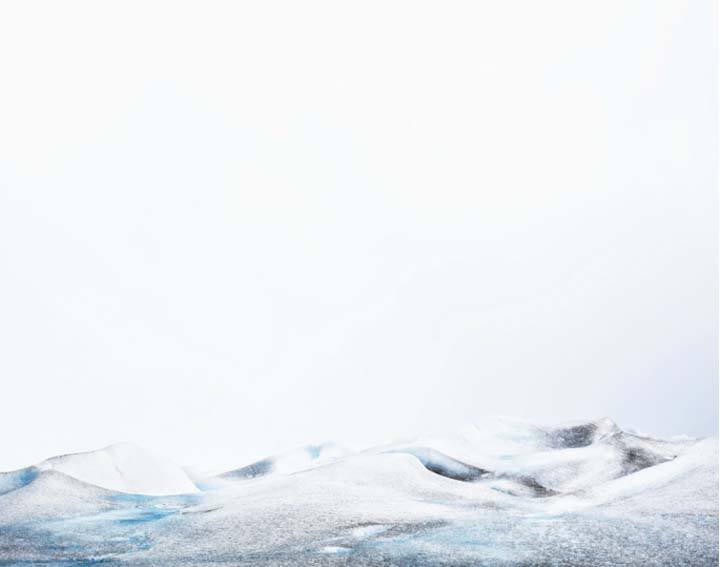Caleb Cain Marcus: A Portrait of Ice
Silence, solitude, vast expanses of forbidding terrain, with no evident human scale. This is the quality of glacial masses, frozen landscapes at Earth’s poles and in between. Caleb Cain Marcus, a photographer living in New York City, became enchanted by the Perito Moreno glacier of Patagonia, in 2010. He spent the next two years traveling the globe to make the images that comprise A Portrait of Ice (Damiani 2012). He writes,
The ice screws chime against my harness as I walk, their song as enchanting as the deep blue beckoning me to the bottom of the crevasse like the Greek sirens. Carefully I place one foot in front of the other, like walking on a tightrope that ends in nothingness. A sheer drop-off on three sides with the sky overhead, I am perched on one foot walking to step across the void from a fin of ice onto a column of ice. I take the step and for a moment my body is the bridge between two towers of ice. I feel the sirens call, my body bending down toward their depths with fascination. Somehow I am able to resist. I look back at the iridescent blue, the whisper still in my ear, and I wonder when it will be my time.

Perito Moreno, Plate III, Patagonia, © Caleb Cain Marcus
Marcus photographed peaks, ridges, valleys, pinnacles, and plains formed in ice since the beginning of time from a high vantage point—which serves to enhance the lack of human scale in places devoid of things we can measure—trees, for example. Instead, he captures the elemental qualities of each glacier, and the pointillistic coloration beyond the bluish-charcoal tint common to ice that is caused by biological flotsam and jetsam such as pollen, dust, and other matter embedded in the ice. The effect he has achieved is to evoke a planetary time scale along the 4th dimension.
In his Introduction, Marvin Heiferman writes, Rather than grand panoramic sweeps of geography, the majority of these images are, surprisingly, vertical. And in them, softly focused expanses of sky appear to be strangely heavy, to compress the landforms into the lower portions of the frame. Instead of picturing monumental walls of ice that advance over and disrupt what lies beneath, or icebergs that break away from glaciers to float majestically, if threateningly, at sea, these photographs suggest that glaciers cover the earth’s surface lightly, like a sheet, rather than bearing down upon it. The jagged rocks, ridges and pinnacles that poke through the frigid surfaces don’t register as being particularly dangerous, but more like the eccentrically rendered landforms you might soar over in a dream or in the elegant flight-simulation of a video game.
The book also includes a text by Professor Robin E. Bell of the Lamont-Doherty Earth Observatory of Columbia University that place glaciation within the perspective of human engagement with ice. In addition, Marcus’s Expedition and Glacier Notes shed light on his personal engagement with the terrain along with facts and folklore about these icy masses. View the images in A Portrait of Ice.


